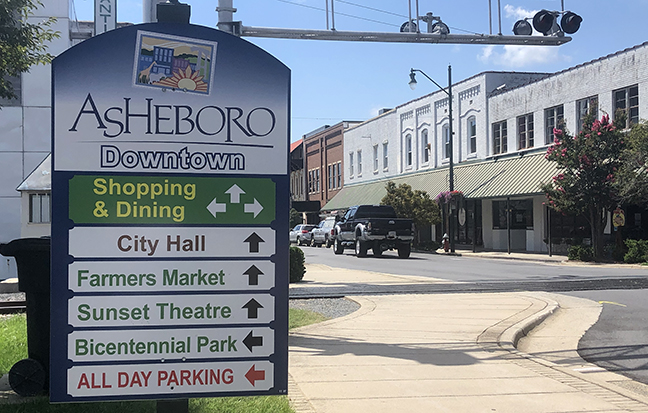Welcome!

Today, Asheboro's enitre downtown area is part of the National Register of Historic Places. Ray Criscoe / Randolph Hub
Historic Downtown District
Janet Imrick
Randolph Hub
Eighty-two buildings in downtown Asheboro now make up a historic district.
Portions of Sunset Avenue and Church, Fayetteville, Hoover, North, Salisbury, White Oak, and Worth Streets were placed on the National Register of Historic Places on April 14, 2022. It promotes the preservation of the existing buildings with financial incentives to property owners who maintain the historic architecture.
"It can oftentimes bridge the financial gap between a rehab of an existing building and what it would cost to demolish and put a new building in the same place," says Brett Sturm, a restoration specialist with the North Carolina Historic Preservation Office.
In 2019, the city hired Fearnbach History Services of Winston-Salem to prepare the nomination for the National Parks Service. The 158-page packet contains an entry describing each structure’s architecture and history. 78 buildings and structures built between 1903 and 1972 were deemed "contributing" to its historic value.
Some buildings within the district already had individual historic designations, including the Acme-McCrary Complex and the Sunset Theatre.
"It makes one cohesive whole out of what had been previously a disjointed collection of individually listed buildings," says Sturm.
Fearnbach worked with Mac Whatley and Ross Holt with the Randolph Library. Asheboro GIS Analyst Curtis Short drew up the map.
Whatley did the first historic preservation inventory for Randolph County in the 1970s. When it comes to documenting a comprehensive history, he says, "It's very hard to backtrack on that today. For one, the county didn't have street addresses back then."
Asheboro's modern downtown began to take shape at the end of the 19th century when the railroad was completed in 1889, bisecting the emerging industrial district to the west and the business district to the east.
"The post office moved to the railroad because the mail came on the train," says Whatley. "And because the post office moved, all the other businesses started doing that, as all your deliveries were coming on the train."
Asheboro Planning and Zoning Administrator Justin Luck says this is part of the city's emphasis on the downtown area. "It's another tool in the toolbox that can help properties. It doesn't mean you have to get a certificate of appropriateness to paint it or swap out a window or cut a tree or anything like that. But it does have the incentives of tax credits for historically accurate rehabilitation."
Property owners can be eligible for a 20 percent federal credit and a 15 percent state credit for qualified costs.
There are no federal restrictions on property owners regarding preservation or upkeep. Sturm says people often confuse the National Register of Historic Places with the National Historic Landmark program, which includes a few notable structures such as the Cape Hatteras Lighthouse or Asheville's Biltmore House.
Regulations for the National Register of Historic Places, he says, only come from the county or municipality.
Luck explains, "We have regulations that prohibit painting of brick or other masonry services that have not previously been painted to try to preserve that character. We have some regulations regarding removing or blacking out windows to try to keep those windows but also keep them transparent and have a lively streetscape."
"None of these apartment conversions would happen without tax credits," says Whatley. "The Asheboro Hosiery one, I think cost $5.5 million, and there was something like $8 million worth of tax credits involved."
Whatley has helped renovate downtown buildings since 1997. While researching his book, he discovered the old ceiling in Courthouse A, preserved beneath a newer drop ceiling.
"I told the county engineer that the ceiling was pretty nice up there. And it will be a real landmark if it was preserved. I think that's probably one of the only interiors that is mentioned in our landmark nomination now because but how pretty it came out to be once we renovated that courtroom."
No matter what the building owners do, Sturm says the National Register serves as a place of prestige.
"This is 158 pages of documentation on downtown Asheboro that will live in perpetuity in the Library of Congress."
